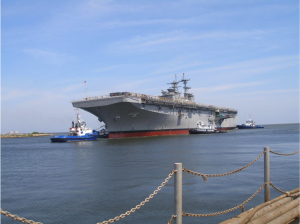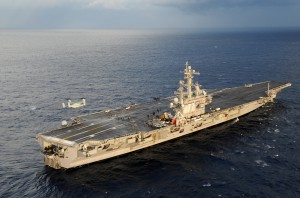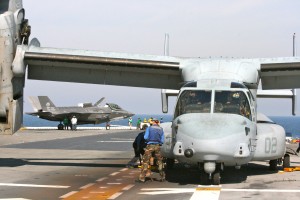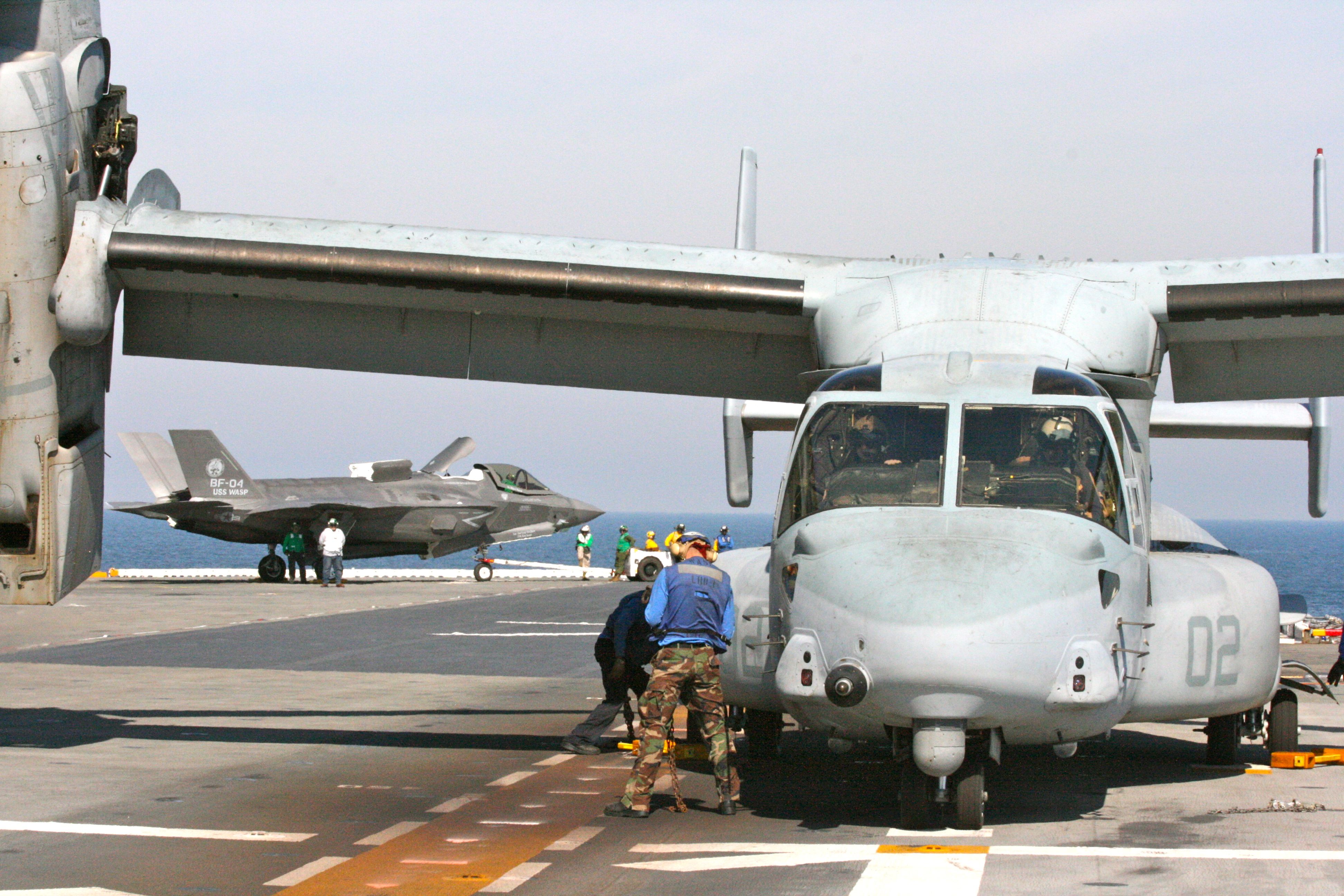2012-11-21 In a four-part follow up set of interviews, Second Line of Defense is looking at the role and impact of the USS America.
Interviews have been conducted with the prospective commander of the ship, the head of amphibious ship building in the USN, a senior USMC general on its role, and with the Deputy Commander, of the 2nd Expeditionary Strike Group, the role of the USS America as a flagship for an ESG is discussed.

Each interview has allowed us to focus on different aspects of the process of change associated with the ship.
With Captain Hall we were able to focus on the integration of different capabilities aboard the ship.
With Captain Mercer, the head of amphibious ship building in the USN, we were able focus on the intersection between those capabilities and innovation in the fleet.
With Col. Bradley Weisz, Deputy Commander of 2nd Expeditionary Strike Group, we focused on the role of the USS America as a potential flagship for an ESG.
And, finally, with Major General Walsh, Deputy Commanding General of the USMC Combat Development Command, we focused on how the ship provides an important impulse to the USMC approach to the future.
Walsh attended the christening of the USS America and with his background in Aviation as former background working at both HQs Marine Corps, in Iraq and at 2nd MAW is well qualified to discuss its impact on USMC operations.
But his current position as Deputy Commanding General, Marine Corps Combat Development Command means that he charged with the responsibility of working for the Corps on thinking through the evolution of expeditionary operations in the period ahead.
The USS America is a new type of large deck amphibious ship. As Captain Hall, the CO of the ship has put it:
We are a large deck amphibious ship, just as the Kearsarge. But we are an aviation-centric large deck amphibious ship and we’ve been designed specifically without a well deck so we can support the next generation of aircraft.
We can get out there with a much larger hanger bay with two high-hat areas to support maintenance on the much larger MV-22s. The maintenance requirements for the F-35 are met and we have the capability to expand when required for future development. With our added fuel, maintenance, supply, support, we can sustain the aviation capability much greater on station.
SLD: How is the USMC planning to leverage this new capability?
Major General Walsh: The Marines focus operationally on being a scalable and tailorable force. We tend to look at a deck as an opportunity to maximize scalability and tailorability for the mission that will be assigned.
We want to be able to disaggregate our assets, and having this capability truly allows us to do that, but it also allows us to aggregate and come together dependent upon the mission.
We will be able to use the new aviation assets combined with greater operational support to those aircraft to expand the scope and range of our ability to support scalable and tailorable forces.

SLD: When we talked just after you got back from Iraq, it was clear that the newest aircraft in the USMC operational kit – the Osprey – was a game changer. The F-35 will be as well. But it will take some time to figure how to use it and how operations will change as a consequence. Don’t you see a direct parallel to marrying the Osprey with the USS America and the future inclusion of the F-35 B onto the America deck?
Major General Walsh: I do. With the CH-46s in Iraq, I had to put out Forward Arming and Refueling Points (FARPs) to support them. This meant sending convoys, equipment, and Marines out to operate and secure the FARPs. This also required protecting the FARPs after they were in place.
With the Osprey, I could simply leap past all of that. The Osprey completely changed how we operated. The demand became to use the Ospreys throughout Iraq because it could go through Iraq in one day easily, and just run around the battle space. It changed completely how we used our heliborne assets.
I expect we will have the same experience with the F-35 B, only more so. When I went from flying F-4s to F-18s that was a shift.
With the F-35 it is a leap of multiple generations of technology all at once.
It’s more of exponential curve than we did when we went from third generation to fourth generation aircraft.
It will not only bring in stealth and precision strike but all electronic attack and C5ISR to the USS America as a presence asset. This will be revolutionary.
SLD: The ship will have a significant upgrade in C5ISR over the USS Kearsarge, for example. And as the F-35B brings its C5ISR capability to the ship, the interaction between the ship and the aircraft, will also shape how the ship can be integrated into the surface and subsurface fleet. What is your perspective on this dynamic?
Major General Walsh: One of the things I participate in is what we are calling the air/sea battle area. I am on the senior steering group as the Marine Corps representative.
One focus area is what we are calling network integrated attack. From a USMC perspective, we are working on integrating such an approach into our presence mission.
We look at the USS America from this perspective.
We are looking to integrate the ship, the aviation assets and the fleet into a single scalable and tailorable operational force.
The ship’s got to be integrated too. It has tremendous capabilities from a mechanical standpoint, the size of it, the structure, hanger base, cranes, and an ability to be able connect and do the things that we need from a command and control standpoint.
But if it can’t connect in this network integrated world, it’s not going to be effective.
It’s got to be plugging in just as with our other platforms are so we can talk to Aegis Cruisers, it can talk to subs, we can talk to the AWACS and it can be plugged into the carrier’s network.
All of this needs to be integrated into one single-joint force.
The Marines focus on going to go where the enemy isn’t, and finding the gaps and seams to insert force.
It is not just about precision warfare.
It is about presence, engagement, and pushing information around the battlespace and sustained operations when necessary.
SLD: From your perspective, the integration of C5ISR from the ship to the aircraft to the ground force and to the fleet is really a central piece of the equation?
Major General Walsh: From a USMC operational perspective, it is central.
We are not going to be doing be able to do all the innovative things that we’re developing with our platforms, our aircraft and what our Marines are going to do ashore if we can’t work an integrated force.
And all the capabilities that we’re developing, like G/ATOR and plugging it in with things like the common aviation command and control system (CAC2S) is central to our effort.
We need to put the glue together to tie the Marine air ground taskforce (MAGTF), with our brothers and sisters out at sea to be able to project power from the sea.

SLD: From the USMC perspective, the F-35 B is a Swiss army navy enabling expeditionary operations. How will it interact with the operational approach of the USS America?
Major General Walsh: Everything we try to do is to buy something that’s going to fit into the toolbox, and provides capabilities for many uses. With the Harriers they were good for one thing—precision attack. They were attack aircraft to really be Marine’s airborne artillery from the sea or move ashore to be that airborne artillery, so we could start getting some more fire support capabilities early in the operation while we phased our artillery ashore.
With the F-35, fire support is just one element. Preparing to insert force and then provide support for that force ashore, the F-35 will provide C5ISR, electronic strike, and guidance to where to maneuver and support the force.
But I’ll tell you, the young guys are hungry to get on with this because they understand that they will be able to support in a 360 degree manner the entire MAGTF. They can not do this with Harriers or F-18s, or the support we get from Navy Growlers.
The F-35 will provide the Air Combat Element (ACE) and the MAGTF the complete package.
This will be an entirely new capability with the F-35 as the combat Swiss army knife connected to the capabilities of the USS America and its power projection assets. The term gamechanger tends to be over used but I truly believe the Litening II will be that set of capabilities.
But my operational experience in Iraq demonstrated that the Osprey was just that.
And the package of USS America, with the Osprey, the C-53K, AH-1Z, UH-1Y and the F-35 Bravo on board will be that in spades.
It will be a MAGTF ACE on steroids.
For the first three interviews in this series see the following:
https://sldinfo.com/captain-hall-discusses-the-uss-america-looking-towards-the-future/
https://sldinfo.com/ship-design-and-innovation-captain-mercer-discusses-the-uss-america/
https://sldinfo.com/the-coming-of-the-uss-america-to-an-expeditionary-strike-group-esg/


